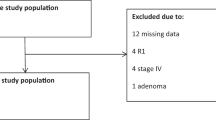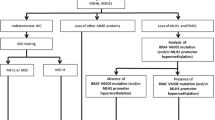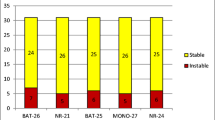Abstract
Microsatellite instability (MSI) is a genetic consequence of a MisMatch Repair defect in colorectal cancer (CRC). We compared clinicopathohistological features with MSI status of CRC and evaluated prognostic significance of MSI status and BRAF mutation in the group of MSI-H tumors. 155 primary CRCs were excised surgically, 2006–2008. MSI analysis was carried out using a fluorescence-based pentaplex polymerase chain reaction technique. BRAF mutation (V600E) was analyzed by direct sequencing in MSI-H tumors. For all patients were evaluated: age, gender, localization, tumor cell type, tumor differentiation, mucin production, lymphocytic infiltration (TILs) and TNM stage. Patients’ disease-free survival (DFS) was compared according to MSI and BRAF status using Kaplan–Meier test. Of the 155 CRCs, 19 (12.3%) were MSI-H, and 136 (87.7%) were MSS/L. BRAF mutations were found in 4 of the MSI-H tumors. Patients with MSI-H CRC had lower recurrence rate (log rank test; P = 0.04) than MSS/L group. Patients with MSI-H tumor and BRAF mutation had worse DFS than MSI-H tumors without this mutation (log rank test; P = 0.01). Most of the clinicopathologic characteristics of MSI-H CRC in Serbian patients are similar to those reported in previous studies. Patients with MSI tumor phenotype had favourable prognosis, but in those with BRAF mutation higher recurrence rate was observed.

Similar content being viewed by others
References
Banerjea A, Hands RE, Powar MP, Bustin SA, Dorudi S (2009) Microsatellite and chromosomal stable colorectal cancers demonstrate poor immunogenicity and early disease recurrence. Colorectal Dis 11(6):601–608. doi:10.1111/j.1463-1318.2008.01639
Boland CR, Thibodeau SN, Hamilton SR, Sidransky D, Eshleman JR, Burt RW et al (1998) A National Cancer Institute workshop on microsatellite instability for cancer detection and familial predisposition: development of international criteria for the determination of microsatellite instability in colorectal cancer. Cancer Res 58:5248–5257
Buhard O, Suraweera N, Lectard A, Duval A, Hamelin R (2004) Quasimonomorphic mononucleotide repeats for high-level microsatellite instability analysis. Dis Markers 20(4–5):251–257. doi:10.1200/JCO.2005.02.7227
Carethers JM, Smith EJ, Behling CA et al (2004) Use of 5-fluorouracil and survival in patients with microsatellite-unstable colorectal cancer mismatch repair proficiency and in vitro response to 5-fluorouracil. Gastroenterology 126:394–401. doi:10.1053/j.gastro.2003.12.023
Deng G, Bell I, Crawley S, Gum J, Terdiman J, Allen B et al (2004) BRAF mutation is frequently present in sporadic colorectal cancer with methylated hMLH1, but not hereditary nonpolyposis colorectal cancer. Clin Cancer Res 10:191–195. doi:10.1158/1078-0432.CCR-1118-3
Domingo E, Laiho P, Ollikainen M, Pinto M, Wang L, French AJ et al (2004) BRAF screening as a low-cost effective strategy for simplifying HNPCC genetic testing. J Med Genet 41:664–668. doi:10.1136/jmg.2004.020651
French AJ, Sargent DJ, Burgart LJ, Foster NR, Kabat BF, Goldberg R et al (2008) Prognostic significance of defective mismatch repair and BRAF V600E in patients with colon cancer. Clin Cancer Res 14(11):3408–3415. doi:10.1158/1078-0432.CCR-07-1489
Greenson JK, Huang S, Herron C, Moreno V, Bonner J, Tomsho LP (2009) Pathologic predictors of microsatellite instability in colorectal cancer. Am J Surg Pathol 33(1):126–133. doi:10.1097/PAS.0b013e31817ec2b1
Ishikubo T, Nishimura Y, Yamaguchi K, Khansuwan U, Arai Y, Kobayashi T et al (2004) The clinical features of rectal cancers with high-frequency microsatellite instability (MSI-H) in Japanese males. Cancer Lett 216:55–62. doi:10.1016/j.canlet.2004.07.017
Jass JR (2007) Classification of colorectal cancer based on correlation of clinical, morphological and molecular features. Histopathology 50:113–130. doi:10.1111/j.1365-2559.2006.02549
Jenkins MA, Hayashi S, O’Shea AM, Burgart LJ, Smyrk TC, Shimizu D et al (2007) Pathology features in Bethesda guidelines predict colorectal cancer microsatellite instability: a population-based study. Gastroenterology 133(1):48–56. doi:10.1053/j.gastro.2007.04.044
Kazama Y, Watanabe T, Kanazawa T, Tanaka J, Tanaka T, Nagawa H (2007) Microsatellite instability in poorly differentiated adenocarcinomas of the colon and rectum: relationship to clinicopathological features. J Clin Pathol 60(6):701–704. doi:10.1136/jcp.2006.039081
Kazama Y, Watanabe T, Kanazawa T, Tanaka J, Tanaka T, Nagawa H (2008) Poorly differentiated colorectal adenocarcinomas show higher rates of microsatellite instability and promoter methylation of p16 and hMLH1: a study matched for T classification and tumor location. J Surg Oncol 97(3):278–283. doi:10.1002/jso.20960
Lamberti C, Lundin S, Bogdanow M et al (2007) Microsatellite instability did not predict individual survival of unselected patients with colorectal cancer. Int J Colorectal Dis 22(2):145–152. doi:10.1007/s00384-006-0131-8
Malesci A, Laghi L, Bianchi P, Delconte G, Randolph A, Torri V et al (2007) Reduced likelihood of metastases in patients with microsatellite-unstable colorectal cancer. Clin Cancer Res 13(13):3831–3839. doi:10.1158/1078-0432.CCR-07-0366
McGivern A, Wynter CV, Whitehall VL, Kambara T, Spring KJ, Walsh MD et al (2004) Promoter hypermethylation frequency and BRAF mutations distinguish hereditary non-polyposis colon cancer from sporadic MSI-H colon cancer. Fam Cancer 3:101–107. doi:10.1023/B:FAME.0000039861.30651.c8
Ng K, Schrag D (2010) Microsatellite instability and adjuvant fluorouracil chemotherapy: a mismatch? J Clin Oncol 28(20):3207–3210. doi:10.1200/JCO.2010.28.9314
Pawlik TM, Raut CP, Rodriguez-Bigas MA (2004) Colorectal carcinogenesis: MSI-H versus MSI-L. Dis Markers 20:199–206
Ribic CM, Sargent DJ, Moore MJ, Thibodeau SN, French AJ, Goldberg RM et al (2003) Tumor microsatellite-instability status as a predictor of benefit from fluorouracil-based adjuvant chemotherapy for colon cancer. N Engl J Med 349:247–257. doi:10.1056/NEJMoa022289
Samowitz WS, Sweeney C, Herrick J, Albertsen H, Levin TR, Murtaugh MA et al (2005) Poor survival associated with the BRAF V600E mutation in microsatellite-stable colon cancers. Cancer Res 65:6063–6069. doi:10.1158/0008-5472.CAN-05-0404
Saridaki Z, Papadatos-Pastos D, Tzardi M, Mavroudis D, Bairaktari E et al (2010) BRAF mutations, microsatellite instability status and cyclin D1 expression predict metastatic colorectal patients’ outcome. Br J Cancer 102:1762–1768. doi:10.1038/sj.bjc.6605694
Shitoh K, Konishi F, Miyakura Y, Togashi K, Okamoto T, Nagai H (2002) Microsatellite instability as a marker in predicting metachronous multiple colorectal carcinomas after surgery. Dis Colon Rectum 45:329–333. doi:10.1007/s10350-004-6177-1
Suraweera N, Duval A, Reperant M, Vaury C, Furlan D, Leroy K et al (2002) Evaluation of tumor microsatellite instability using five quasimonomorphic mononucleotide repeats and pentaplex PCR. Gastroenterology 123(6):1804–1811. doi:10.1053/gast.2002.37070
Ward R, Meagher A, Tomlinson I, O’Connor T, Norrie M, Wu R et al (2001) Microsatellite instability and the clinicopathological features of sporadic colorectal cancer. Gut 48:821–829. doi:10.1136/gut.48.6.821
Westra J, Schaapveld M, Hollema H et al (2005) Determination of TP53 mutation is more relevant than microsatellite instability status for the prediction of disease-free survival in adjuvant-treated stage III colon cancer patients. J Clin Oncol 23:5635–5643. doi:10.1200/JCO.2005.04.096
Yearsley M, Hampel H, Lehman A, Nakagawa H, de la Chapelle A, Frankel WL (2006) Histologic features distinguish microsatellite high from microsatellite-low and microsatellite-stable colorectal carcinomas, but do not differentiate germline mutations from methylation of the MLH1 promoter. Hum Pathol 37:831–838. doi:10.1016/j.humpath.2006.02.009
Acknowledgments
This work was supported by Ministry of Science; Republic of Serbia: Grant No 41033.
Conflict of interest
The authors declare that they have no conflict of interest.
Author information
Authors and Affiliations
Corresponding author
Rights and permissions
About this article
Cite this article
Markovic, S., Antic, J., Dragicevic, N. et al. High-frequency microsatellite instability and BRAF mutation (V600E) in unselected Serbian patients with colorectal cancer. J Mol Hist 43, 137–143 (2012). https://doi.org/10.1007/s10735-011-9387-6
Received:
Accepted:
Published:
Issue Date:
DOI: https://doi.org/10.1007/s10735-011-9387-6




